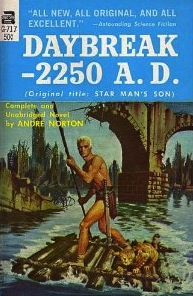Post-Holocaust Noble Savages
This is what your next doctor's visit will sound like after you get your genome sequenced:
Wilson Tucker’s 1952 The Long Loud Silence is The Road of the 1950’s.
It’s a pure survival story, one about the complete deterioration of society into a vicious, gritty state of no-holds-barred struggle after a nuclear and biological holocaust. Unlike many other post-apocalyptic novelists, Tucker doesn’t envision much society left at all after total destruction: there is no reversion to a pseudo-Native American tribal state, to early rural 19th century agrarianism, to feudalism, to a theocratic dystopia. A total Hobbesian (or Darwinian) state of nature prevails for decades after the catastrophe. Society does not rebuild.
For our 1951 pick, we have the work of one of the great British writers of sci-fi’s Golden Age. In The Day of the Triffids, John Wyndham presents a horror story of giant, ambulatory, flesh-eating plants that topple humans from their dominance of a world they thought they had tamed. The theme is common to other post-apocalyptic stories of the 1950’s: we may tame nature with our technological wizardry, but our undoing is our inability to tame ourselves. We take our dominance of the planet for granted - and it wouldn’t take much to find ourselves in a relentlessly hostile world where we have compete as a species with a new top dog.
Our 1950 pick is L. Sprague de Camp and P. Schuyler Miller's Genus Homo, a pulp adventure that takes place a million years in the future after after the genus Homo has destroyed itself, leaving the field wide open for other ape species to evolve higher intelligence, science, and technological war. Although Genus Homo was first published in book form in 1950, it was written for the pulp magazine Super Science Stories in 1941, and thus it really counts as a pre-Hiroshima novel. Nevertheless the book makes a clear reference to the possibility of humanity’s destruction by nuclear bombs, putting it firmly in the post-apocalyptic genre.
With 1949, we arrive at one of the big classics in the post-apocalyptic genre. George Stewart’s Earth Abides is epic in both scope and ambition, a bittersweet story that captures the immense scale on which nature operates, and which portrays the scientific achievements of human civilization as a minor ripple in nature’s broad course. It is a book focused on big themes: the reversibility of human history, the connection between technology and civilization, the impermanence of human achievements.
 Melville on Science vs. Creation Myth
Melville on Science vs. Creation Myth Non-coding DNA Function... Surprising?
Non-coding DNA Function... Surprising? Yep, This Should Get You Fired
Yep, This Should Get You Fired No, There Are No Alien Bar Codes In Our Genomes
No, There Are No Alien Bar Codes In Our Genomes







